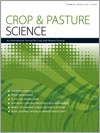Pearl millet (Pennisetum glaucum L.) is an important fodder and is a potential feedstock for fuel ethanol production in dry areas. Our objectives were to assess the effect of elevated CO2 and/or reduced irrigation on biomass production and levels of sugars and proteins in leaves of pearl millet and to test whether mycorrhizal inoculation could modulate the effects of these abiotic factors on growth and metabolism. Results showed that mycorrhizal inoculation and water regime most influenced biomass of shoots and roots; however, their individual effects were dependent on the atmospheric CO2 concentration. At ambient CO2, mycorrhizal inoculation helped to alleviate effects of water deficit on pearl millet without significant decreases in biomass production, which contrasted with the low biomass of mycorrhizal plants under restricted irrigation and elevated CO2. Mycorrhizal inoculation enhanced water content in shoots, whereas reduced irrigation decreased water content in roots. The triple interaction between CO2, arbuscular mycorrhizal fungi (AMF) and water regime significantly affected the total amount of soluble sugars and determined the predominant soluble sugars in leaves. Under optimal irrigation, elevated CO2 increased the proportion of hexoses in pearl millet that was not inoculated with AMF, thus improving the quality of this plant material for bioethanol production. By contrast, elevated CO2 decreased the levels of proteins in leaves, thus limiting the quality of pearl millet as fodder and primary source for cattle feed.
How to translate text using browser tools
24 July 2015
Pearl millet growth and biochemical alterations determined by mycorrhizal inoculation, water availability and atmospheric CO2 concentration
Eliseu G. Fabbrin,
Yolanda Gogorcena,
Átila F. Mogor,
Idoia Garmendia,
Nieves Goicoechea
ACCESS THE FULL ARTICLE

Crop and Pasture Science
Vol. 66 • No. 8
July 2015
Vol. 66 • No. 8
July 2015
arbuscular mycorrhizal fungi
biomass
carbohydrates
Climatic change
Pennisetum glaucum
proteins




